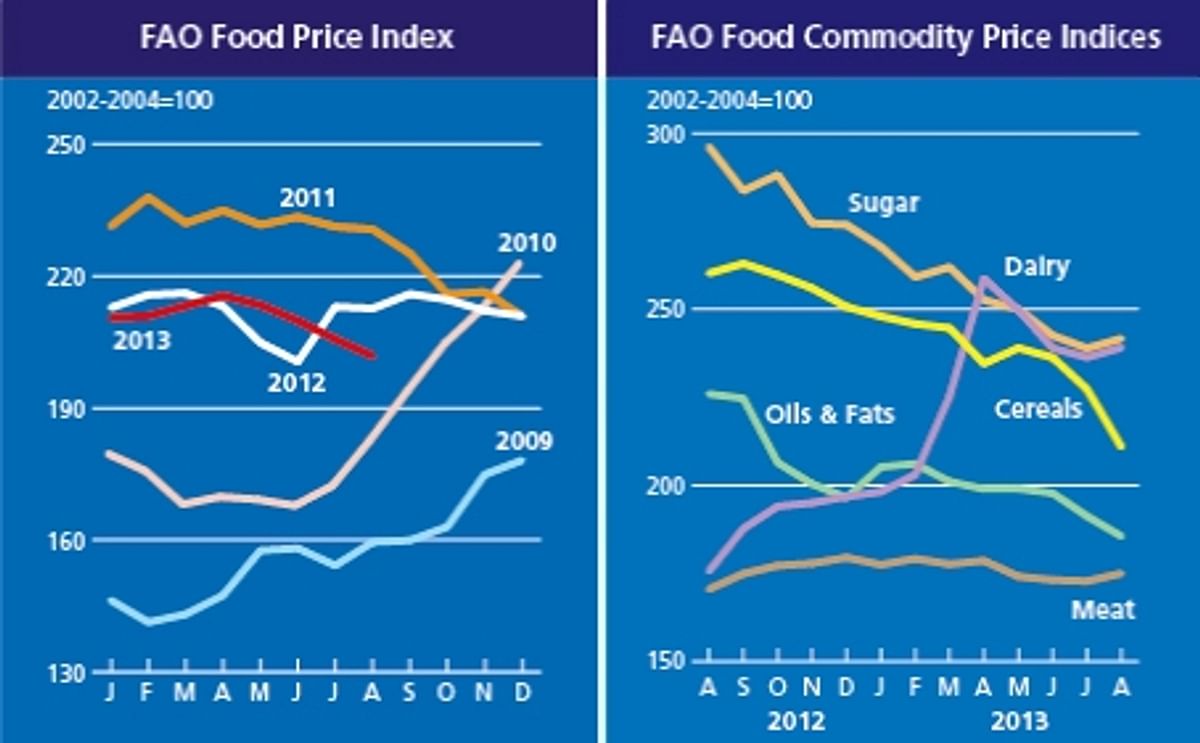The FAO Food Price Index averaged 201.8 points in August 2013, nearly 4 points (1.9 percent) below its July value and 11 points (or 5.1 percent) less than in August 2012. Last month’s decline, the fourth in a row, was driven by continued falls in the international prices of cereals and oils, as dairy, meat and sugar prices rose slightly.
The FAO Cereal Price Index averaged 210.9 points in August, down 16.4 points (7.2 percent) from July and 49.4 points (or 19 percent) from August 2012. This steep decline follows an already sizeable drop in July, is consistent with expectations for strong growth in world cereal production this year and, especially, a sharp recovery in maize supplies. While prices of wheat and rice were down by 2 to 3 percent, the fall reached 14 percent in the case of maize in spite of some late-month gains on concerns over drought and heat stress conditions in the United States.
The FAO Oils/Fats Price Index averaged 185.5 points in August, 5.7 points (or 3.0 percent) below the July value and the third consecutive monthly decline. The slide in the index continued to be driven by palm oil, as ample inventories in Southeast Asia kept prices under pressure. Soy oil values first eased on abundant export availabilities from Argentina and generally good crop prospects for 2013/14, only to regain strength when the United States lowered the forecast for its own forthcoming soy harvest. Overall, however, the prospect of expanding total vegetable oil supplies in 2013/14 is pointing towards a general decline in vegetable oil prices.
The FAO Dairy Price Index averaged 239.1 points in August, 2.8 points (1.2 percent) more than in July and 37 percent above its level in August last year. Prices increased last month for all the dairy products that make up the index, except butter, as export supplies remain limited in major trading countries. Furthermore, with milk production declining seasonally in the northern-hemisphere and the new production season only just starting in Oceania and South America, availabilities for the remainder of 2013 are uncertain. This has lent support to prices, as importers seek to cover commitments for coming months. Strongest growth was recorded for skimmed milk powder, which rose by 2.7 percent, following a similar change in July;whole milk powder prices also increased.
The FAO Meat Price Index averaged 175.0 points in August, an increase of 2.2 points (1.3 percent). The rise mainly reflected stronger prices for pig meat, which rose by 4.5 percent, as those of other types of meat changed little. An important element sustaining pig meat prices was the strengthening of the Euro relative to the US Dollar. Poultry prices registered a fourth consecutive monthly decline, dropping by 1.3 percent, partly as a result of lower feed costs.
The FAO Sugar Price Index averaged 241.7 points in August, up 2.7 points (1.1 percent) from July. The small rebound in sugar prices after three months of consecutive declines was mostly due to estimates showing that Brazil, the world’s largest sugar producer and exporter, was using more sugarcane for ethanol production at the expense of sugar. Overall, sugar prices displayed large volatility during the month, amid uncertainties regarding the size of the anticipated production surplus in the major producing areas.
Source: FAO Food Price Index
World Food Prices continue to fall

Like to receive news like this by email? Join and Subscribe!
Join Our Telegram Channel for regular updates!
Sponsored Content
Sponsored Content
Sponsored Content
Sponsored Content
Sponsored Content










